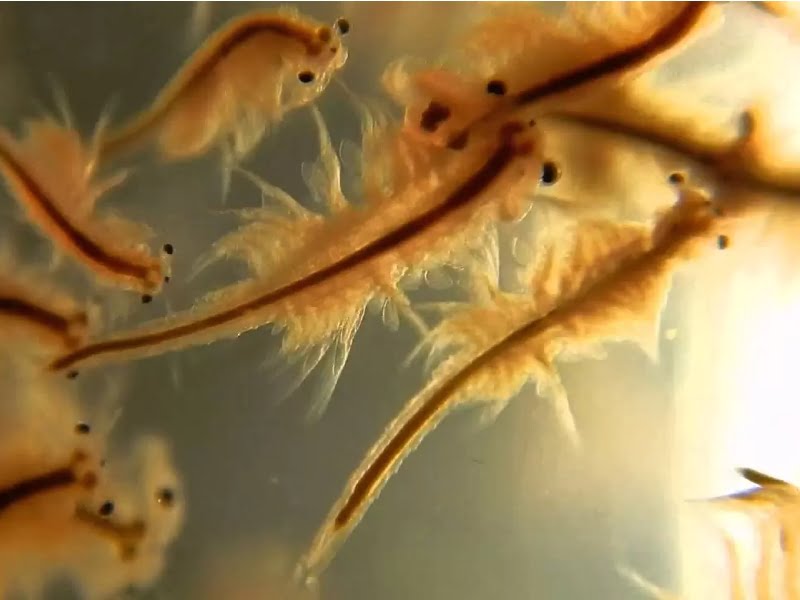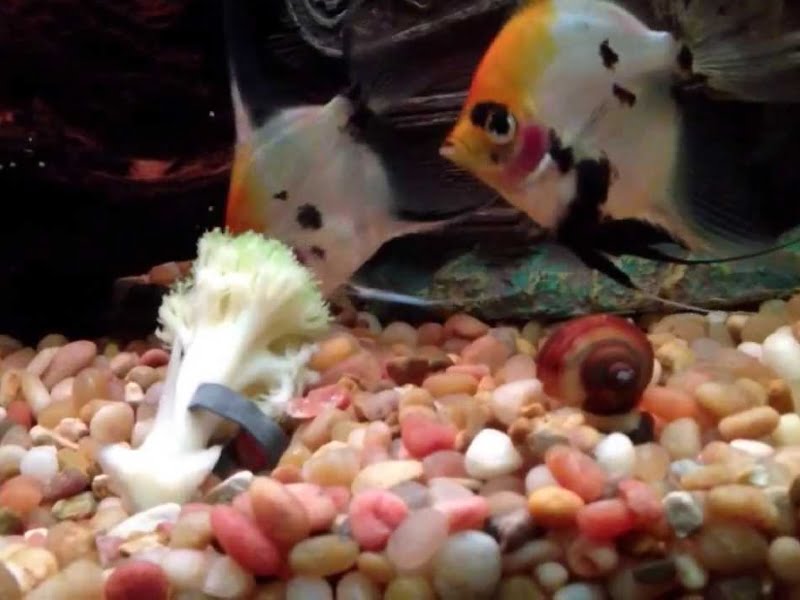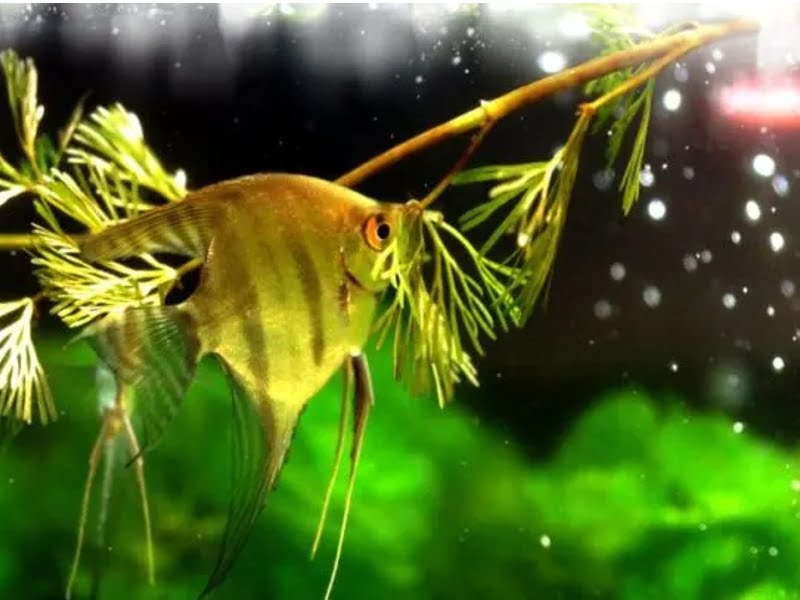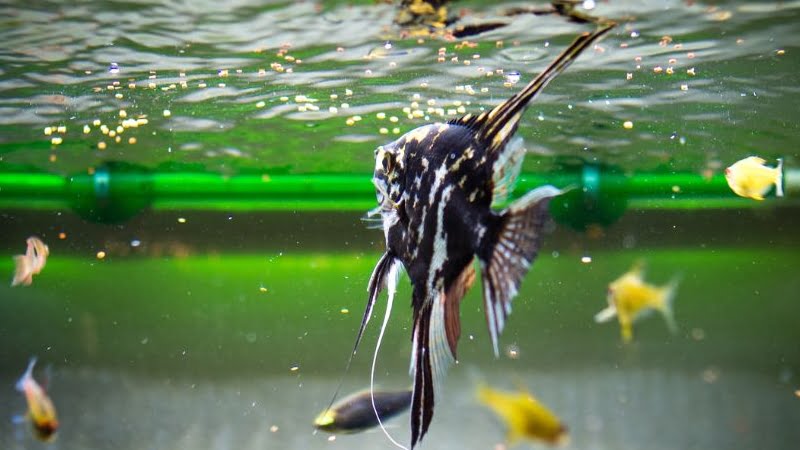It’s easy to remember all the angelfish food that will support their healthy growth if you follow the tips I provide below. Angelfish are omnivores, so they definitely can consume a wide range of food, from protein-rich worms and crustaceans to vegetables. But, is there any detail that we are missing here when it comes to feeding angelfish? I will tell you everything you need about the best angelfish food.
Related Articles
- Top 5 Best Flake Food For Angelfish And How To Choose Them | Handy Aquarium Tips
- Are Your Angelfish Not Eating? 4 Tips To Get Them Back On Track
- Do Angelfish Eat Snails? 8 Outstanding Features That You May Not Know
- Will Angelfish Eat Shrimp – Top 3 Reasons & How To Prevent This
Angelfish Diet In The Wild
In the wilderness, angelfish seek out prey, such as small crustaceans, insects, larvae, and other meaty food items rich in protein. Recreating this healthy diet in your aquarium is crucial to allow your angelfish to thrive. This is especially important if you’re trying to induce the spawning process.
In any environment, angelfish are voracious species. So it’s crucial to provide them with abundant food without contaminating the water with excessive leftovers.
Angelfish Favorite Food In Captivity
Angelfish in captivity share a similar diet to the ones in the wild. Nevertheless, they can consume and are attracted to commercial frozen angelfish food of good quality as well, while wild angelfish don’t tend to pay for this type of food much of their mind.
Fresh Brine Shrimps (Variable Size Depending On The Fish Size)

The brine shrimp is an extremely efficient and energy-rich food source. The protein content of brine shrimps is as high as 60% of their weight. This makes them a great option if you require food items to aid in developing the young fish. As for adult fish, they will gladly feed on adult brine shrimps if they get in the tank.
It’s no surprise that you must also feed your angelfish fries and brine shrimps. The difference is that you have to find newly laid eggs. This is the ideal food choice simply because the newborn Angelfish require a lot of nutrients, and brine shrimps can provide them with these.
Brine shrimp can survive under fresh water for thirty minutes or more. Overfeeding is not recommendable because it’s hard to filter the water clean when there are a bunch of micro shrimps inside.
Bloodworms And Other Frozen Angelfish Food
Bloodworms and other frozen food items (even beef heart with no fat) can last very long in storage and aren’t at risk of transmitting harmful parasites to your tank. Therefore, many aquarists choose frozen food as a part of the main diet for their angelfish.
Although many fish owners gladly throw frozen bloodworms into the tanks, it is best to avoid this, especially if the fish community is prone to temperature fluctuations. It could also cause discomfort in their digestion. We suggest filling a container using the water from the aquarium to defrost the bloodworms or other frozen food.
And since frozen food tends to be more chunky, you can attempt target feeding if you notice some angelfish are hauling all the food for themselves, leaving other weaker fish starving.
Algae Or Vegetable

Angelfish can and will consume algae that grow in your tank, and they don’t seem picky about the type of algae, from slime to filamentous algae. They can help you clean the tank.
Because angelfish are omnivores, it is essential to meet their requirement for vegetables. Please take a look at boiling some peas, then removing their shells and cutting the peas into tiny pieces. Your angelfish will adore this diet (if combined with meaty angelfish food). Cucumber, zucchini, or fresh lettuce are also great vegetables for angelfish.
Flake Food
The most nutritious flake food available for angelfish is made of spirulina. This ensures they get the right amount of plant matter to feed their omnivorous nature. The best ones have a high amount of spirulina (40 percent) and have a good supply of multivitamins.
Nevertheless, flake food high in protein is still the best for angelfish. Angelfish are famous for their vibrant colors, and a diet full of protein and vitamins will ensure their colors stay beautiful and striking.
Live Bait Fish
This is a slightly more expensive way to feed angelfish, but I believe it’s pretty efficient. Many types of live bait fish with beautiful colors in the carp species will accompany angelfish well. If the angelfish don’t eat them, your tank has some extra colorful friends. If they eat the small bait fish, we don’t have to give them food too frequently daily.
As we all know, angelfish are semi-aggressive and tend to eat anything that can fit in their mouth. So, for example, neon tetras or small tetras will be easy prey for them.
Tips On How To Feed Live Food For Angelfish
There are only 3 things you must remember when feeding live food to angelfish. Explore the tricks with me below!
Control The Portions Of Angelfish Food
Overfeeding is a no-no for any aquarium since it requires more frequent cleaning. It may lead to the development of some bacteria, parasites, or flatworms like planaria in the tank. Feeding angelfish 2 to 3 times per day should be more than enough. If plants or algae are in your tank, feeding the fish 2 times in a small amount will trigger them to eat more algae.
When we feed them live food like brine shrimps or bloodworms, it’s wise to use a tweezer and place food in different spots in the tank to ensure that all member gets their portion of food.
Keep In Mind Where The Fish Eat

Angelfish are mid-swimmers and eat at this layer of water or near the surface. When giving them live food, avoid dunking the pieces in the bottom of the tank because they won’t enjoy having to dive into eating.
Avoid giving away too much food because the significant amount will fall into the bottom and become leftovers in 5 minutes. Fish won’t touch this food. Later on, we will have to clean it.
Does The Food Sink?
Some angelfish food items float while the others sink. Spread the food near the surface in small portions so that the angelfish have time to finish them up before they drop slowly to the mid-layer of water or the bottom.
I recommend picking flakes or pellets that don’t sink too quickly because the fish won’t have to rush into eating them, and they don’t fall to the bottom too fast and become waste. Leftover food isn’t always processed by the water filter and can get stuck between rocks and gravel. This is an ideal condition for bacteria, diseases, and parasites to thrive and strike. We should avoid that.
Video: What to feed Freshwater Angelfish – Best Food For Angelfish.
FAQs
What is the best food for angelfish?
Angelfish prefer meat to vegetables despite being able to consume both. Therefore, it is advisable to provide them with food items like brine shrimps, bloodworms, larvae, or even smaller fishes.
Do angelfish need special food?
No, this fish species will consume almost anything. They can eat live fish and frozen fish food like bloodworms or blackworms without any problem. When feeding them vegetables, we just have to chop them into smaller pieces (not too small nor too many).
How often should you feed an angelfish?
For an adult angelfish, it is recommended to feed between 2 and 3 times per day. In excess, it is harmful to the fish and tank’s ecosystem. If you provide your angelfish too much, it could cause digestive issues constipation, and cause swelling in the belly. Because of their slim bodies, they are more susceptible to digestive issues.

Annette M. Chaney is an experienced marine biologist with over 20 years of experience as an aquarist and fishkeeper. She started her first aquarium at a young age, filling it with frogs and goldfish obtained from the ten-cent pet store.
Annette grew up caring for and breeding African Cichlids, which led to a hobby in high school that doubled as a profitable means. Attending Reed College gave her time to solidify herself as an accomplished aquarium caretaker with an eye for sales. After that, from 2009 – 2013, she studied at Roger Williams University – one of the most prestigious universities for Aquaculture and Aquarium in USA. She is the founder of AquariumCircle since 2010.
